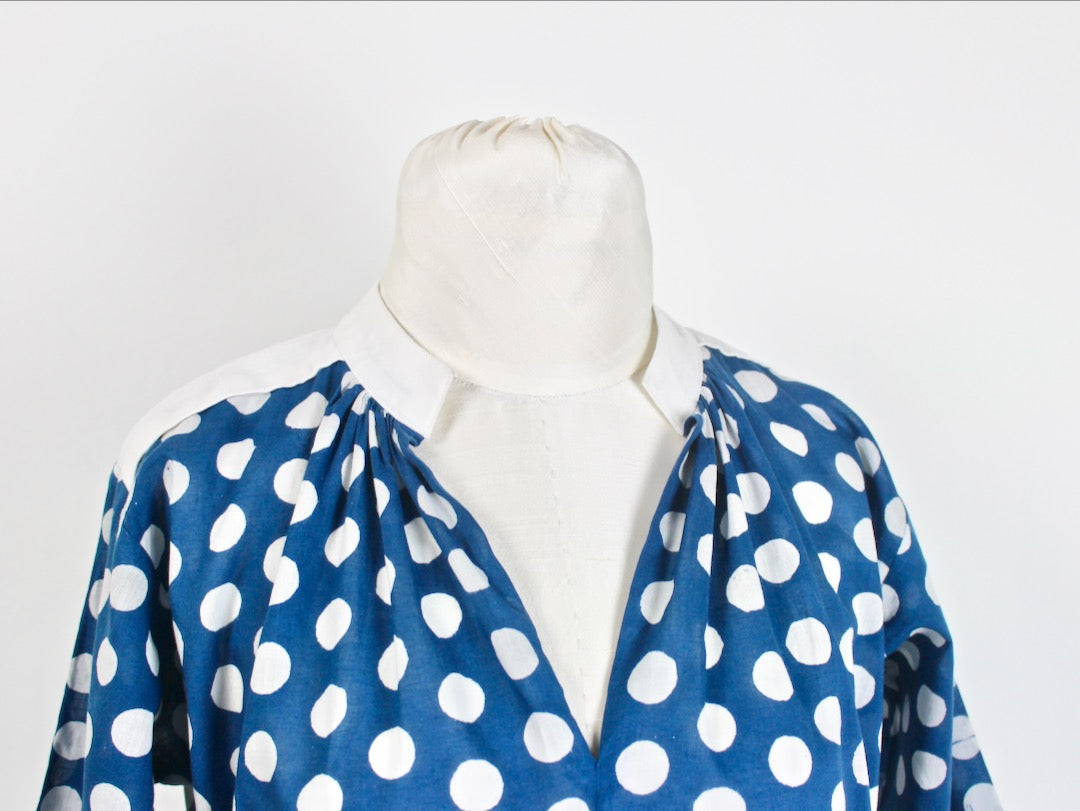When I first saw the Matcha Top pattern by Sew Liberated (I think on the Sew House Seven blog), I was smitten! Such a lovely neckline.

I am fairly new to indie pattern companies, since I hate to spend hours fitting in order to learn how each new company’s offerings fit, but this design is quite simple, without a lot of fitting issues. It also looked like the perfect pattern to try out some of the cotton voiles in stock at Loom & Stars.

In fact I already knew which fabric I wanted to use: natural indigo hand block prints had just arrived for spring! Most of these are on cambric, a plain-weave cotton fabric lighter and softer than quilting cotton, which is perfect for most garment-making. But the polka dots are on soft, airy cotton voile; it’s the same base as all of our natural indigo-dyed shibori fabrics. It has a fantastic drape so I knew it would gather nicely around the neckline of the Matcha top to create gentle fullness.

Except I wanted a dress, not a top. No problem: I just lengthened both the front and back pattern pieces by about 20 inches, following the gentle flare from the waistline. The pieces just barely fit in the three yards of fabric which I had prepared by hand washing. To highlight the unique features of this pattern, namely the collar and shoulder detail, I used lightweight white linen. (Since the shoulder pieces are an overlay, I cut each side double and treated the two layers of linen as one, to prevent the blue fabric underneath from showing through.)

Because the pattern is generously sized, and because I prefer a good fit through the shoulders, I made the top one size smaller than my measurements called for. This was not a problem except at the armscye, which was very small, so I whacked off about 5/8 inch at the the bottom of the armholes on both front and back. Though this increases the overall diameter of the armscye, luckily the sleeve still more or less fit the seam.

Construction was straightforward, with only a few minor annoyances, including some confusion about the neckline. Two notches are given for neckline depth: regular and “dramatic”, and the pattern suggests most people might prefer the regular one. I compromised and made a notch somewhere in between, but after happily sewing away found that I could barely get the dress over my head. Most vexing! So I picked the seam open down to what was probably the level of the original drama-neckline and patched my beautifully bound opening edges as best I could. It would have been wise to reinforce the bottom of the V (with a bit of fusible interfacing for example), but the pattern did not suggest this and, sadly, I didn’t think of it until it was too late.

Otherwise the pieces fit together well, except for the shoulder detail piece which didn’t quite match around the garment neckline for my size; this was puzzling, though unimportant. Of course the collar is the focal point of this pattern, and it did turn out really well. I edge stitched it to keep it nice and flat, since the shoulder details were also edge stitched.

French seams on the center front and side seams create a clean finish inside, and I also added pockets, yay! Not just Any Old Pockets, but what I think of as Ingenious Indian Pockets, which I first encountered on my husband’s kurtas. Does anyone else find those standard scoop-shaped side seam pockets that flap around inside your dress super annoying?

Indian pockets, on the other hand, are a flat thing stitched inside the garment (see the inside view above). They are centered under the side seam opening, so the pocket bag is supported and actually stays in place. Sure, the stitched outline is visible on the exterior of the garment, which some people might not like, but in this case I choose “form follows function”. Here's a tutorial to learn how to make this pocket.
One last change: knowing the dress might be rather shapeless (though I knew I would wear it with a belt), I gathered part of the dress back at the waistline and stitched a small piece of fabric over it, to keep the gathers in place. This is hidden by the belt and holds a large amount of fullness in place better than the belt would alone.

After it was hemmed and finished, the dress did look like what I feared: a big bag. But I borrowed a white linen belt from another dress and… I absolutely loved it! The voile is soft and flowing, the gathers pleasingly full, and the neckline so eye-catching! I also love how the block print fabric has some delightful drippy bits here and there, which remind us that it was, indeed, printed by hand. Now I want to make a Matcha dress in every one of our indigo shibori voiles… or would that be a bit excessive? This pattern is also a fabulous choice for our handwoven jamdani cottons. Make one for yourself and send us a photo!


